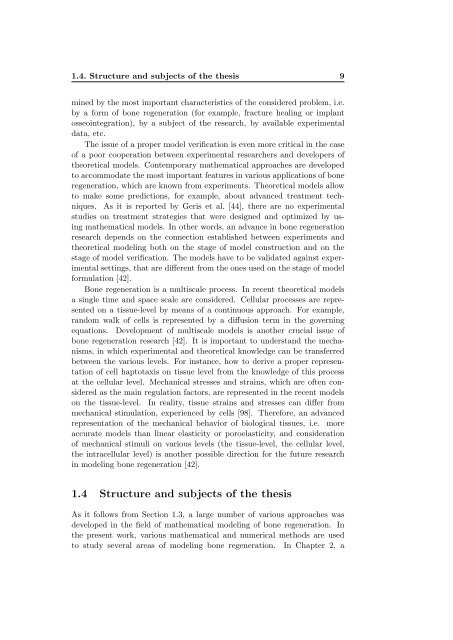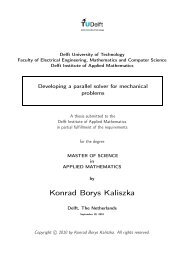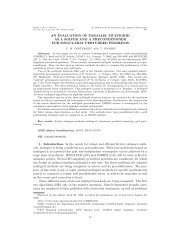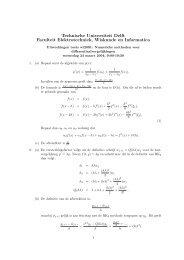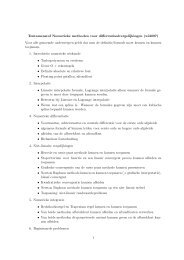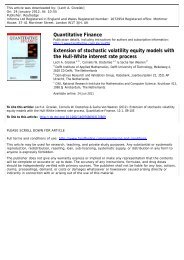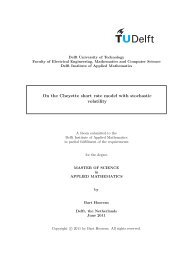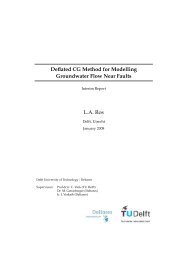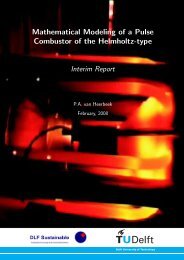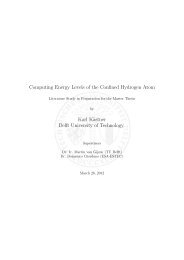Modeling bone regeneration around endosseous implants
Modeling bone regeneration around endosseous implants
Modeling bone regeneration around endosseous implants
Create successful ePaper yourself
Turn your PDF publications into a flip-book with our unique Google optimized e-Paper software.
1.4. Structure and subjects of the thesis 9mined by the most important characteristics of the considered problem, i.e.by a form of <strong>bone</strong> <strong>regeneration</strong> (for example, fracture healing or implantosseointegration), by a subject of the research, by available experimentaldata, etc.The issue of a proper model verification is even more critical in the caseof a poor cooperation between experimental researchers and developers oftheoretical models. Contemporary mathematical approaches are developedto accommodate the most important features in various applications of <strong>bone</strong><strong>regeneration</strong>, which are known from experiments. Theoretical models allowto make some predictions, for example, about advanced treatment techniques.As it is reported by Geris et al. [44], there are no experimentalstudies on treatment strategies that were designed and optimized by usingmathematical models. In other words, an advance in <strong>bone</strong> <strong>regeneration</strong>research depends on the connection established between experiments andtheoretical modeling both on the stage of model construction and on thestage of model verification. The models have to be validated against experimentalsettings, that are different from the ones used on the stage of modelformulation [42].Bone <strong>regeneration</strong> is a multiscale process. In recent theoretical modelsa single time and space scale are considered. Cellular processes are representedon a tissue-level by means of a continuous approach. For example,random walk of cells is represented by a diffusion term in the governingequations. Development of multiscale models is another crucial issue of<strong>bone</strong> <strong>regeneration</strong> research [42]. It is important to understand the mechanisms,in which experimental and theoretical knowledge can be transferredbetween the various levels. For instance, how to derive a proper representationof cell haptotaxis on tissue level from the knowledge of this processat the cellular level. Mechanical stresses and strains, which are often consideredas the main regulation factors, are represented in the recent modelson the tissue-level. In reality, tissue strains and stresses can differ frommechanical stimulation, experienced by cells [98]. Therefore, an advancedrepresentation of the mechanical behavior of biological tissues, i.e. moreaccurate models than linear elasticity or poroelasticity, and considerationof mechanical stimuli on various levels (the tissue-level, the cellular level,the intracellular level) is another possible direction for the future researchin modeling <strong>bone</strong> <strong>regeneration</strong> [42].1.4 Structure and subjects of the thesisAs it follows from Section 1.3, a large number of various approaches wasdeveloped in the field of mathematical modeling of <strong>bone</strong> <strong>regeneration</strong>. Inthe present work, various mathematical and numerical methods are usedto study several areas of modeling <strong>bone</strong> <strong>regeneration</strong>. In Chapter 2, a


